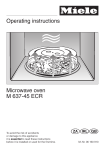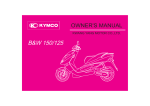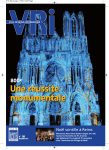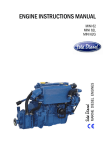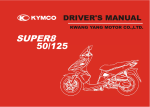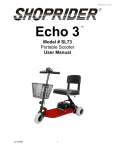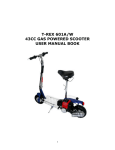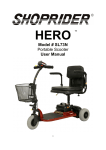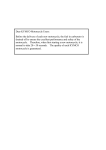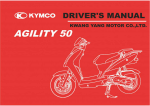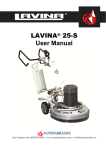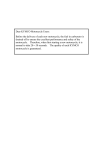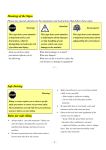Download Kymco People 250 Owners Manual
Transcript
OWNER'S MANUAL
KWANG YANG MOTOR CO.,LTD.
PEOPLE 250
Dear KYMCO Scooter Users:
Thank you for purchasing this KYMCO scooter and welcome to the
family of KYMCO scooter riders. To enjoy safer and more pleasant
riding, become thoroughly familiar with this owner manual before you
ride the scooter. You safety depends not only on your own alertness
and familiarity with the scooter but also the scooter mechanical
condition. A pre-ride inspection before every outing and regular
maintenance are essential. The quality of each KYMCO scooter is
guaranteed.
Note: 1. The information and specifications stated in this manual are for
reference only and subject to change without notice.
2. When starting the engine, the battery must be installed to
facilitate starting and increase the engine performance.
TABLE OF CONTENTS
1.PRECAUTIONS FOR A SAFE RIDING
2.ASSEMBLY PARTS
ENGINE NUMBER. FRAME NUMBER
3.OPERATION INSTRUCTIONS
IGNITION SWITCH/STEERING HANDLEBAR LOCK
ELECTRIC STARTER BUTTON. HEADLIGHT SWITCH
ENGINE STOP SWITCH
HEADLIGHT DIMMER SWITCH/PASSING SIGNAL SWITCH
HORN BUTTON/TURN SIGNAL SWITCH
SEAT LOCK/MET-IN BOX
HELMET BUCKLE
CELL PHONE SOCKET
REAR CUSHION
INSTRUMENTS
4.PRE-RIDE INSPECTION
ADVANCE INSPECTION. ENGINE OIL LEVEL INSPECTION/REFILLING
1
3
7
8
8
10
11
12
13
14
15
16
17
18
21
21
TABLE OF CONTENTS
BRAKE FLUID LEVEL INSPECTION
22
24
25
26
HORN/LIGHT INSPECTION
27
COOLING SYSTEM. TIRE INSPECTION
FUEL LEVEL INSPECTION/REFILLING
STEERING HANDLEBAR. INSTRUMENT LIGHTS INSPECTION
FRONT/REAR SHOCK ABSORBER INSPECTION. BRAKE PERFORMANCE
INSPECTION. REAR MIRROR ANGLE CHECK. LICENSE PLATE CHECK.
REFLECTOR CHECK. PREVIOUS ABNORMAL PARTS INSPECTION.
LUBRICATION POINT CHECK
5.ENGINE STARTING METHODS
6.NORMAL RIDING METHOD
7.PRECAUTIONS FOR RIDING
8.HOW TO STOP RIDING
9.EASY MAINTENANCE
28
29
32
35
38
40
AIR CLEANER INSPECTION AND AIR CLEANER CLEANING&
REPLACEMENT
APPEARANCE CLEANING
40
41
TABLE OF CONTENTS
BATTERY
FUSE CHANGE
ENGINE OIL CHANGE
TRANSMISSION GEAR OIL
42
43
45
46
SPARK PLUG INSPECTION
BRAKE FLUID LEVEL INSPECTION/REFILLING. RUBBER COVER
47
INSPECTION FOR WIRE AND CABLE
48
49
50
51
52
10.IMPORTANT NOTICES
POLLUTION-FREE PERIODIC MAINTENANCE SCHEDULE
SPECIFICATIONS
WINDSHIELD INSTALLATION
1.PRECAUTIONS FOR A SAFE RIDING
(1) CLOTHES
To relax and wear comfortable clothes are the main
points for a safe riding.
To observe traffic laws, keep a cool mind, relax and be
careful will provide you a safe riding.
Wear helmet and fasten it tightly.
Have the clothes well-arranged. Fasten shirt cuffs and
keep them from hooking the brake lever.
Wear low-heeled shoes for a safe riding.
When riding, use both hands to grasp the handlebar. It
is very dangerous to hold the handlebar with one hand.
CAUTION:
A scooter rider should not wear loose or too long
clothes to avoid danger.
During riding or 10 minutes after the scooter is
stopped, do not touch the exhaust muffler to avoid
scalding.
When parking the scooter, keep it away from dry
lawn or inflammables to avoid danger.
-1-
(2) RIDING METHOD
The safety of two-wheel vehicles is influenced by sitting
position. The rider should sit on the central part of the
seat cushion. If the rider sits on the rear part of the seat,
the load of front wheel will decrease. As a result, the
handlebar will swing and cause danger to the rider.
When making a turn, it will be easier for the rider to
steer the scooter by leaning the body inward slightly.
The scooter will lose its balance if the rider fails to
keep his body leaning inward.
When riding on a damaged or macadam road. Slow
down the speed and hold the handlebar tightly.
(3) CARRYING GOODS
Keep a good sitting posture to operate the scooter
properly.
The feel of the handlebar will be different when carrying
goods on the scooter. Overloading may cause the
handlebar to swing. Avoid riding with overload.
Max. loading capacity of the met-in box is 10kg.
Max. loading capacity of the rear carrier is 6kg.
-2-
2. ASSEMBLY PARTS
Fuel Fill Cap (P.24)
Center Hook
Met-in Box(P.14)/HELMENT
BUCKLE(P.15)
Cell Phone
Socket(P.16)/Met-in Box
Lamp
Rear Carrier(P.2)
Air Cleaner(P.40)
Rear Tire(P.22)
Main Stand
Engine Serial Number(P.7)
Side Stand(P.34)
-3-
Battery(P.42)/Fuse(P.43)
Seat(P.14)
Frame Serial Number(P.7)
Reserve Water Tank Eye
Hole(P.22)
Ignition Switch(P.8)
Front Tire(P.22)
Exhaust Muffler
-4-
Headlight
Left Back Mirror
Rear Brake Lever
Left Front Turn Signal Light
Left Front Cushion
Right Front Cushion
Right Front Turn Signal Light
Front Brake Lever
Right Back Mirror
-5-
Instruments(P.18)
Engine Stop
Switch(P.11)/Headlight
Switch(P.10)/Electric Starter
Button(P.10)
Throttle Grip
Right Rear Turn Signal Light
Right Rear Cushion(P.17)
Left Rear Cushion(P.17)
Left Rear Turn Signal Light
Taillight/Stoplight
Headlight Dimmer Switch(P.12)/
Passing Signal Switch(P.12)/Turn
Signal Switch(P.13)/Horn
Button(P.13)
CAUTION:
If the windshield is used that read and understand of the label on the windshield:
"The windshield influences the way that scooter drives and handles. Drive carefully in case of
strong wind and always used two hands and the handlebar."
-6-
ENGINE NUMBER
The engine number is marked on left engine case.
Please write down your engine number in place
below.
FRAME NUMBER
The read frame number, please remove with a
screwdriver the cover on inner cover.
Always check that the frame number marked on
your scooter is the same written in document and
warranty scooter is the same written in document
and warranty card.
Please write down your frame number in place blow.
-7-
3. OPERATION INSTRUCTIONS
(1) IGNITION SWITCH/STEERING
HANDLEBAR LOCK
:At this position, power is connected to start
the engine. The key cannot be taken out.
:At this position, power is cut off and the
engine stops. The key can be taken out.
:At this position, the steering handlebar is
locked. The key can be taken out.
:At this position, power is cut off and the
engine stops, but the key can not be taken
out.
-8-
《Locking Method》
Turn the steering handlebar left to the full and then
push and turn the ignition switch key left to the "
"
position. The handlebar can be locked.
CAUTION:
After locking, turn the handlebar gently to make sure
that it is locked.
" position
Do not turn the ignition switch to the"
during riding, otherwise the handlebar will be out of
control and cause accidents.
Don't park your scooter at a place to hinder the traffic.
《Unlocking Method》
Push and turn the ignition switch key right to the "
and the "
" is released automatically.
-9-
"
(2) ELECTRIC STARTER BUTTON
To start the engine, first turn on the ignition switch
("
")and then push the electric starter button. At
this time, be sure to fully apply the front or rear brake
lever (pedal) in order to connect the power.
INE
ENG TOP
S
CAUTION:
During engine running, do not push the electric starter
button to avoid engine damage.
Turn the headlight switch off and turn signal switch off
before using the electric starter button.
Release the electric starter button immediately after
the engine is started.
IN E
ENG P
S TO
(3) HEADLIGHT SWITCH
At this position, the position light, headlight,
instrument lights and taillight turn off together.
At this position, the position light, instrument lights
and taillight light turn on.
At this position, the position light, headlight,
instrument lights and taillight light all turn on.
-10-
(4) ENGINE STOP SWITCH
The engine can be stopped when the engine stop
switch at this position "
" and it won't start
even though the ignition switch is "
".
The engine can be started when stop switch at this
position "
" but the ignition switch shall be turned
"
".
CAUTION:
The engine stop switch is only used for temporary
engine stop.
When the scooter is parked and the engine stop
switch is not used, be sure to turn "
" the ignition
switch to avoid battery overcharge.
-11-
INE
ENG TOP
S
(5) HEADLIGHT DIMMER SWITCH/PASSING
SIGNAL SWITCH
Switch to this position for using high beam.
When riding in downtown area or there is a
car coming from the opposite direction, use
low beam to avoid affecting the visibility of
coming cars.
CAUTION:
This indicator light comes on when the long distance
light is turned on.
PASSING When passing,if there are cars coming
fromthe opposite direction, press and
release the PASSING switch and the
headlight will wink to warn the coming
cars.
PASSING
HTS
LIG
-12-
(6) HORN BUTTON/TURN SIGNAL SWITCH
When the ignition switch key is turned the"
"
position, push the horn button and it will sound.
For turning to the right.
For turning to the
left. Push the turn signal switch button to release it.
Horn Button.
The horn and turn signal switch do not work when the
ignition switch is the"
".
CAUTION:
The turn signal light will not release automatically. Be
sure to reset it after use; otherwise it may affect the
traffic safety.
-13-
(7) SEAT LOCK/MET-IN BOX
Unlock the seat and put the helmet in the MET-IN box.
《Unlocking Method》
Stop the engin and turn the ignition switch to the "
"
position. Turn the key left to unlock the seat.
If the engin is running. Keep the ignition switch key
at the "
"position and also push it left to unlock
the seat.
To lock the seat, push on it until it lock automatically.
Make sure the seat is secure before riding.
CAUTION:
Never put the key inside the seat cushion to lock the
seat.
The lamplight and met-in indicator light will come on
while the seat is unlock, make sure the seat is locked.
-14-
(8) HELMET BUCKLE
1.Open the seat with the ignition switch key and lift
up the seat.
2.Put the helmet retaining ring into the helmet
buckle.
3.0ut down the seat and it will lock automatically.
Take out the helmet in the reserve order of the
above steps.
CAUTION:
When riding, wear the helmet and do not retain it on
the scooter to avoid damage of coated parts.
-15-
(9) CELL PHONE SOCKET
When inserting the cell phone charger into the
socket.
The charging indicator light of instrument will
become to red.
《Operation Method》
Insert the cell phone charger into the socket,
then put the cell phone at cell phone polder.
CAUTION:
Please close the protective cover of socket while it
won't be used.
The cell phone socket only supply power. It can't be
cut off the power supply automatically when the
power of the cell phone is enough.
The standard accessories of this model don't include
the cell phone charger.
To avoid the cell phone overcharged, please follow all
of the cell phone charger manufacturer's instruments.
The quality of the cell phone and the cell phone
charger is not guaranteed.
-16-
12V
DC CKET
SO
(10) REAR CUSHION
To suit scooter behaviour to load condition rear
cushion could be adjusted in spring preload.
Using the special tool in tool kit change the
preload.
It is possible to adjust rear cushion in three
positions:
position "hard"
position "medium"
position "soft"
When you adjust rear cushion, the spring preload
of rear cushions on either side must be the same.
-17-
(11) INSTRUMENTS
TURN SIGNAL INDICATOR LIGHT(LEFT): When the
turn signal switch is operated, this indicator light will
wink.
OIL PRESSURE INDICATOR: The indicator will tell
you the oil pressure of the engine is lower (The engine
is working and oil pressure indicator is lighting), please
go to KYMCO service station to check the engine oil
level and oil pump or the oil leaks.
CHARGING INDICATOR LIGHT: The cellular indicator
light will come on when the cellular inside the seat is
under charging.
MET-IN INDICATOR LIGHT : The met-in indicator light
will come on when the seat is opened.
HIGH BEAM INDICATOR LIGHT: This indicator light
comes on when the long distance light is turned on.
TURN SIGNAL INDICATOR LIGHT(RIGHT): When the
turn signal switch is operated, this indicator light will
wink.
TEMPERATURE GAUGE: It indicates the temperature
of engine cooling water. During riding, the temperature
gauge needle should always move under the red mark,
If the needle points the red mark, check the coolant level
in the reserve tank.
-18-
MILEAGE COUNTER: The total riding mileage is
indicated by kilometer. The figure in black and white is
an unit of 100m.
SPEEDOMETER: The riding speed is indicated by
km/houror mph.
FUEL RESERVE INDICATOR: The fuel reserve
indicator lights when there is only few fuel left in the
tank. Refill nonleaded gasoline as soon as possible.
FUEL GAUGE: The fuel gauge is to show the volume of
gasoline in the fuel tank. If the fuel gauge pointer is at
the red area, the fuel is insufficient. Refill 92# or 95#
nonleaded gasoline as early as possible.
-19-
2
3
2 CLOCK METER: It displays time and date which can
be adjusted manually.
3 ADJUST KEY: They are used to correct time and date
4 OIL CHANGE INDICATOR LIGHT: The indicator light
will tell you the time of oil change . Usually, the display
is in blue color and it will turn red when oil change is
required..
4
CAUTION:
x
The dixplay color will turn red after riding of 2000km.
Although the display color is still blue upon the first
change of a riding of 300km, it is necessary to insert
the key into the release hole to release it. If not doing
so, the odometer counted for oil change will be
incorrect.
SERVICE
x
-20-
4. PRE-RIDE INSPECTION
(1) ADVANCE INSPECTION
Get into a good habit of inspection before riding. For the
sake of safety and to prevent vehicle damage and traffic
accidents, the pre-ride inspection is absolutely required.
CAUTION:
Be sure to perform inspection and maintenance for your
new scooter after it is ridden for 300km.
(2) ENGINE OIL LEVEL INSPECTION/REFILLING
Place the scooter on its main stand. Take out the oil
dipstick and wipe it clean.
Directly insert the oil dipstick into the engine oil.
(Don't screw it in.)
Take out the oil dipstick and check the oil level. If it is
close to the lower limit, add engine oil to the upper limit.
CAUTION:
The temperature of engine and exhaust muffler is very
high. When checking the oil level, be careful to avoid
scalding.
Riding with insufficient engin oil will cause breakdown
easily.
-21-
(3) COOLING SYSTEM
1.Place the scooter on its main stand on level ground.
2.Check if the coolant level of the reserve tank is
between the upper and lower level lines. If necessary,
remove the reserve tank cap and fill to the upper level
line with distilled water.
3.If the coolant level is too low. It means that there are
abnormal conditions.
Inspect the radiator and hoses for coolant leaks.
4.Use only distilled water to refill the reserve tank in
order to ensure good performance of the cooling
system.
H : Upper lever
L : Lower lever
x
H
L
-22-
U.S.
L
0 70 0
8
50 6E
40 GTAIRUGE PSi 90
0
0
10
3
20
P
10
AT E
NT
(4) TIRE INSPECTION
1.Tire Pressure Check
Check if the tire pressure is normal when the tire is in
contact with level ground.
If there is any abnormal condition, check the tire
pressure with a tire pressure gauge.
Measure the tire pressure under room temperature.
2
The tire pressure must not overpass 2.50kg/cm
2. CRACKS & DAMAGE
Check the tire-contact area for crack or damage.
3. ABNORMAL WEAR
Check the tire-contact area for abnormal wear.
4. FOREIGN OBJECTS OF METAL PIECE & GRAVEL
Check the tires and tire-contact area for imbedded
objects of metal piece and gravel.
5. DEPTH OF TIRE GROOVE
If the tire is worn to the wear limit indication mark,
replace it with a new one.
NORMAL PRESSURE(1 Rider / 2 Riders )
2
Front Wheel
1.75/2.0 kgf/cm
Rear Wheel
2
1.75/2.0 kgf/cm
CAUTION:
Abnormal tire pressure, crack, damage and abnormal
wear will cause unsteady handlebar and result in tire
break.
If the tire has cracks or is worn to the wear limit
indication mark, replace it with a new one.
-23-
(5) FUEL LEVEL INSPECTION/REFILLING
Check if the fuel is sufficient.
If the fuel gauge pointer is at red grid, refill #92 or #95
nonleaded gasoline as soon as possible.
《Refilling Method》
1.Stop the engine before refilling.
2.Turn the ignition key directly from the"
" to the"
"
position, then open the fuel fill cap automatically.
3.Push the fuel fill cap to lock.
4.Make sure that the key is at the "
starting the engine.
" position when
CAUTION:
The gasoline level shall not exceed the reference plate;
otherwise the fuel will penetrate out.
When refilling, do not add other additives to avoid engine
breakdown.
-24-
(6) STEERING HANDLEBAR
Visually inspect the steering handlebar for damage.
Apply the front brake and move the handlebar upward
and downward to check for abnormal noise.
Move the steering handlebar upward, downward,
rightward and leftward to check for any loose parts.
Check if the handlebar rotates freely.
If any abnormal condition is found, go to your scooter
dealer or for inspection.
(7) INSTRUMENT LIGHTS INSPECTION
Check the turn signal indicator lights, high beam
indicator light, met-in light for proper operation.
Check the speedometer for proper operation.
Check the fuel gauge for proper operation.
Check the coolant temperature gauge for
proper operation.
-25-
(8) BRAKE FLUID LEVEL INSPECTION
Keep the handlebar straight and check the front/rear
brake reservoir for brake fluid level which should be
kept between the upper and lower limits.
Check the brake shoes for wear when the fluid level
is close to the lower limit.
Recommended Brake Fluid: DOT 4
Front Brake
Rear Brake
Lower Limit
CAUTION:
Do not mix brake fluid of different brands. It may cause
brake failure and is very dangerous. When refilling
brake fluid, use towels to cover and protect the painted
and coated surfaces.
-26-
(9) HORN/LIGHTS INSPECTION
" position and push
Turn the ignition switch to the "
the horn button to check if it sounds.
Headlight/Taillight Inspection:
Start the engine and turn on the headlight switch to
check if the headlight and taillight are good and check
the light shells for dirt and damage.
Stoplight Inspection:
Apply the front and rear brake levers respectively to
check if the stoplight is good. And also check the stop
light shell for dirt and damage.
Turn Signal Light Inspection:
Operate the turn signal switch to make sure whether
the right/left front and rear turn signal lights can wink
and buzz. Also check the light shells for dirt and damage.
Headlight
Taillight/ Stoplight
Turn signal light
Horn button
CAUTION:
Replace any dirty or damaged lights with new ones to
avoid danger during riding.
-27-
(10) FRONT/REAR SHOCK ABSORBER INSPECTION
Check the condition of the front/rear shock absorbers
by pressing down on the handlebar and seat several
times.
(11) BRAKE PERFORMANCE INSPECTION
Fully apply the front and rear brake levers and move
the scooter forward to see if the braking effect is
good.
(12) REAR MIRROR ANGLE CHECK
Sit on the scooter uprightly and make a viewing
test of the rear mirror angle.
(13) LICENSE PLATE CHECK
Check the license plate for dirt and damage, then
tighten it.
(14) REFLECTOR CHECK
Check the reflector for dirt and damage.
(15) PREVIOUS ABNORMAL PARTS INSPECTION
Make sure that the previous abnormal parts are
repaired.
(16) LUBRICATION POINT CHECK
Visually check if all motorcycle lubrication points are
lubricated properly.
-28-
Oil
5. ENGINE STARTING METHODS
(1) TURN THE IGNITION SWITCH "
"
Unlock the steering handlebar.
Turn the ignition switch to the "
" position.
CAUTION:
Check the gasoline volume and engine oil level before
starting the engine.
Be sure to erect the main stand while starting the
engine and side stand is up.
Before starting the engine , the side stand shall be
kicked up to secure safety.
(2) LOCK THE REAR WHEEL
Apply the rear brake lever to connect the power for
starting.
CAUTION:
In order to prevent the scooter from rushing out at
high speed, make sure to lock the rear wheel.
If free play of the rear brake lever is incorrect, the rear
wheel cannot be braked and it will cause danger easily.
-29-
(3) USE THE ELECTRIC STARTER BUTTON
Push the electric starter button without rotating the
throttle grip.
If the engine fails to start after the electric starter button
is pressed for 3~4 seconds when it is warm, rotate the
throttle grip for 1/8~1/4 turn to facilitate starting.
When the scooter is not used for a long time or the
fuel tank is empty, if the engine is still hard to start after
the fuel tank is refilled with gasoline, slightly turn the
throttle grip and push the electric starter button for
several times to start the engine.
In order to avoid battery overcharge, do not push the
starter button more than 5 seconds.
If the engine does not start after the electric starter
button is pushed for 5 seconds, wait for more than 5
seconds and then push the button again.
-30-
PASSING
1/8~1/4
CAUTION:
Don't push the electric starter button while the engine is
running; otherwise the engine will be damaged.
When starting the engine, the rear brake lever must be
applied to connect power and the stoplight will come on
when power is connected.
-31-
INE
ENG TOP
S
6. NORMAL RIDING METHOD
(1) STARTING THE ENGINE
Start the engine by referring to the starting methods
specified in Section 5.
CAUTION:
Keep your finger away from the button immediately
after the engine is started to avoid engine damage.
The rear brake lever should be kept at the braking
position before riding.
(2) REBOUND THE MAIN STAND
Keep the rear brake lever at braking position and
push the scooter forward, then the main stand will
rebound automatically.
CAUTION:
After starting the engine and before moving, do not
turn the throttle grip to increase the engine rpm.
-32-
INE
ENG TOP
S
(3) CORRECT SITTING POSITION
Ride astride on the scooter from the left side and
sit upright. Touch the ground with left foot to avoid
slipping.
CAUTION:
The rider must wear helmet, gloves and goggles.
Do not wear any clothes which will affect riding safety.
(4) ROTATE THE THROTTLE GRIP
Release the rear brake lever and slowly rotate the
throttle grip, then the scooter will move smoothly.
CAUTION:
After the rear wheel brake lever is released, do not
rotate the throttle grip suddenly to prevent the scooter
from rushing out.
During riding, do not accelerate or decelerate rapidly
and suddenly to save fuel and prolong the scooter life.
-33-
(5) SIDE STAND
The scooter has a safety device for side stand. When
the side stand is "down". The engine can't be started.
When the side stand is "up". The engine can be started.
The engine can't started when the safety device is faulty.
You can remove the left side cover by screwdriver and
shift the side stand switch coupler to prepared wire
coupler which for engine running without safety device.
CAUTION:
A tool kit is provided with your scooter and stored in
the storage bag under seat. The tool kit includes
screwdriver and screwdriver handle.
The safety device remain with the scooter at all times
and be serviced by authorized KYMCO dealer as soon
as possible if it is faulty.
Side Stand Switch Coupler
Prepared Wire Coupler
-34-
7. PRECAUTIONS FOR RIDING
(1) CORRECT RIDING
Before moving, turn on the turn signal light and make
sure whether the rear side is safe.
Do not rush into the car lanes and always keep the
motorcycle to the right side to avoid danger.
CAUTION:
Moderate riding will prolong the engine service life.
The clutch linings are worn more quickly when often
ridden at low speed.
(2) SPEED CONTROL
The speed is controlled by the throttle grip.
ROTATE The speed will become faster. Don't be
hasty to accelerate.
When riding on an ascending road, rotate
the throttle grip gradually to increase the
horse power.
RESTORE The speed will become slower. Restore
the throttle grip quickly.
CAUTION:
Apply the brake level while restoring the throttle grip.
This will shorten the time required to slow down.
-35-
(3) PROPER RIDING WILL PROLONG THE ENGINE
LIFE
For a new scooter, keep the speed below 60km per
hour within the first 1000km of riding.
Avoid sudden acceleration and long-time riding at high
speed.
In hot weather, the engine overheats easily at long-time
idling. Stop the engine in this case.
CAUTION:
Moderate riding will prolong the engine life.
(4) APPLY BOTH FRONT AND REAR BRAKE
LEVELS WHEN BRAKING
First restore the throttle grip to the closed position and
then pull the brake levers tight.
The best way to brake the scooter is to pull the brake
levers "slowly" at the beginning, then pull them tight.
CAUTION:
Apply single brake lever will cause the scooter to slip.
During riding, never brake the scooter suddenly.
It may cause the scooter to slip and could be very
dangerous.
-36-
60KM
(5) DO NOT MAKE SUDDEN STOP OR SHARP TURN
Sudden stop and sharp turn are the main causes for
slipping and could be very dangerous.
In rainy days the road is slippery. Sudden stop will
cause the motorcycle to slip. Be careful to avoid
danger.
(6) BE MORE CAREFUL WHILE RIDING IN RAINY
DAYS
A longer braking distance is required in rainy days
than in sunny days. Be sure to slow down and brake
the scooter slowly as soon as possible.
When riding on a descending road, restore the throttle
grip to closed position and slow down by making
intermittent braking.
CAUTION:
A longer braking distance is required in rainy days. Be
sure to slow down and brake the scooter slowly as
soon as possible.
-37-
8. HOW TO STOP RIDING
(1) WHILE GO NEAR THE PARKING PLACE
Turn on the turn signal light in advance. Watch out
vehicles coming behind or aside and stop the scooter
to the right side slowly.
Restore the throttle grip to closed position and apply
the front and rear brake levels as soon as possible.
At this moment, the stoplight will come on to warn the
vehicles coming behind.
(2) WHILE THE SCOOTER IS COMPLETELY
STOPPED
Return the turn signal switch to its original position.
" position to
Turn the ignition switch key to the "
stop the engine.
CAUTION:
During riding, never operate the ignition switch key.
"
When the ignition switch key is turned to the"
position, the electric system does not work which may
result in traffic accident. Turn off the ignition switch
key after the scooter is fully stopped.
-38-
(3) PARKING
Place the scooter on its main stand on level ground
and do not hinder the traffic.
Stand on the left side and grip the handlebar straight
with left hand and the side rod or rear carrier with
right hand. Then, step down the main stand evenly
with right foot and pull the scooter backward by
force with right hand.
CAUTION:
The scooter may easily fall down if it is parked on an
uneven ground.
(4) HANDLEBAR
After parking, be sure to lock the steering handlebar
and take out the key to prevent pilferage. (Refer to P9.)
CAUTION:
Don't park your scooter at a place to hinder the traffic.
The temperature of engine and exhaust muffler is very
high. Be careful to avoid scalding.
Park the scooter at a safe place and be sure to take
out the key to prevent pilferage.
-39-
9. EASY MAINTENANCE
(1) AIR CLEANER INSPECTION AND AIR CLEANER
CLEANING & REPLACEMENT
Take out the air cleaner and visually check if it is dirty or
clogged.
1.Remove the screws attaching the air cleaner cover
and remove the air cleaner cover.
2.Remove the air cleaner element.
3.The installation sequence is the reverse of removal.
Clean the air cleaner element with compressed air.
Replace the air cleaner element at very 4000km.
The air cleaner requires more frequent cleaning or
replacing when ridden in unusually dusty areas. When
replacing, refer to P.50 Periodic Inspection &
Maintenance Schedule.
CAUTION:
Never use oil or solvent to wash the wet type paper
element.
Be careful not to allow water to enter the air cleaner;
otherwise it may result in hard starting.
If the air cleaner is not installed properly, dust may be
sucked into the cylinder directly to reduce engine
horsepower and affect the engine life.
-40-
(2) APPEARANCE CLEANING
Often wipe clean the scooter appearance to
prevent accumulated dust affecting the function of
components.
CAUTION:
If a scooter is not used for a long time, check the
operation of each part and replace lubricants before
riding. Ride the scooter only after its performance is
confirmed.
When waxing the scooter, make sure that the
ingredients of the wax will not damage the paint of the
scooter.
-41-
(3) BATTERY
This model adopts the battery which needs no refilling
of distilled water.
When cleaning the terminal terminals, remove the
screws attaching the battery cover on the met-in box
and then open the battery cover.
When battery terminals are corroded, take out the
battery for cleaning.
After cleaning, apply a thin coat of grease or vaseline
to battery terminals and then install the battery.
CAUTION:
Never open the closed-type battery electrolyte cap.
If the scooter will not be used for a long time, the
battery will discharge electricity by itself. Remove the
battery and put it in a cool place after it is fully charged
to prevent electricity leakage.
If the scooter will not be used for a long time, remove
the negative (-) terminal.
Do not smoke or allow flames or sparks near the
battery while removing and installing it.
Turn off the ignition switch before removal or
installation.
The negative (-) terminal shall be removed first and
the positive (+) terminal shall be installed first.
Tighten the loose terminal nuts securely.
-42-
Battery Charger
(4) FUSE CHANGE
Remove met-in box and fuse cover.
Turn off the main switch and check if the fuse is burned
out.
When the fuse is burned out, replace with a specified
fuse.
Check for the cause of breakdown before replacing.
Prepared Fuse: 10A(red)
15A(blue)
30A(green)
Fuse Cover
CAUTION:
Be careful not to excessively expand the fuse clip
during removal.
After a new fuse is installed, check the fuse clip for
looseness which is the main cause of trouble.
Never use fuse of unspecified capacity, it may cause
wire overheating and burning out.
When replacing electric appliances (lights,
instruments),be sure to use the recommended genuine
parts.
When washing the scooter, avoid flushing it.
If the cause can not be found, contact our distributor or
service station for inspection.
-43-
Replacement
SPECIFICATION
Charge Fuse: 30A(green)
Headlight Fuse: 15A(blue)
Ignition Fuse: 10A(red)
Main Fuse: 15A(blue)
Fan Fuse: 10A(red)
-44-
(5) ENGINE OIL CHANGE
1.Place the scooter on its main stand on level ground.
2.Remove the oil dipstick.
3.Remove the drain bolt to drain the oil.
4.Refill fresh engine oil for 0.9 liter. Firmly tighten the oil
dipstick.
5.Warm up the engine and check the oil level again after
the engine is stopped for 20~30 seconds.
Specified Oil: SAE15W40
Capacity/Exchanging Capacity:1.1L/0.9L
CAUTION:
When changing the engine oil, also clean the oil
strainer and reinstall it.
Use the specified engine oil.
Change engine oil at first 300km and then change it
at every 2000km.
Engine oil will deteriorate easily and require more
frequent change if the scooter is often ridden in
dusty and cold areas or ridden for short distance.
Do not mix engine oil of different classes or viscosities.
It may cause damage to engine.
-45-
Drain bolt
(6) TRANSMISSION GEAR OIL
Check the transmission gear oil tank for leakage.
1.Place the scooter on its main stand on level ground.
After the engine stops for 2~3 minutes, remove the
gear oil check bolt to check the oil level.
2.If the oil level is lower than the check bolt hole lower
edge, add gear oil to the lower edge.
3.After refilling, securely tighten the check bolt.
Recommended Gear Oil: SAE90
Capacity / Exchanging Capacity: 0.20L / 0.18 L
Gear Oil Filler (Check Bolt Hole)
Drain Bolt
Oil Level
CAUTION:
Add gear oil through the oil check bolt hole.
After refilling, use a rag to wipe clean.
Excess or insufficient gear oil will affect the engine
performance.
Never use gear oil of different brand or inferior quality
which may result in engine breakdown.
Change gear oil at first 300km and then change at every
4000km. Add specified gear oil whenever it is necessary.
-46-
(7) SPARK PLUG INSPECTION
Check the spark plug side electrodes for wear.
Fouling deposits on spark plug electrodes and big gap
may result in weak spark.
Spark Plug Removal:
1.Remove the spark plug with a spark plug remover.
2.The installation sequence is the reverse of removal.
Spark Plug Cleaning:
1.It is better to remove spark plug deposits with a spark
plug cleaner.
2.If a spark plug cleaner is not available, clean with a
wire brush.
The side electrode gap is 0.6~0.7mm.
Specified Spark Plug: DPR-7EA-9
Decarbonizing
Cracks, Damage
Gap, Wear,
Fouling Deposits
CAUTION:
Clean the spark plug at every 2000km and replace it
with a new one at every 5000km or when the center
electrode is burned out.
First screw in the spark plug with fingers and then
tighten with a spark plug wrench.
Use unspecified spark plug may damage the engine.
-47-
(8) BRAKE FLUID LEVEL INSPECTION /REFILLING
Remove the two screws from the brake fluid tank and
take off the cover.
Add recommended brake fluid DOT 4 into the tank until
the fluid level reaches the upper limit and then put on
the cover and tighten the screws.
Recommended Brake Fluid: DOT 4
CAUTION:
Do not mix brake fluid of different brands. It may cause
brake failure and is very dangerous. When refilling
brake fluid, use towels to cover and protect the painted
and coated surfaces. (Replace at 10000km or every
year.)
(9) RUBBER COVER INSPECTION FOR WIRE AND
CABLE
The cable cores are protected by the rubber cover
outside the connector. Check the rubber cover
frequently for proper installation.
When washing the scooter, do not flush the rubber
cover directly or brush it. Use a wet rag to wipe off dirt
and dust.
Rubber Cover
Check Points
-48-
10. IMPORTANT NOTICES
(1) WHEN THE ENGINE FAILS TO START OR STOPS
DURING RIDING
Is the gasoline enough?
If the fuel gauge pointer is at the red line, refill #92 or
#95
nonleaded gasoline.
Is the way to start the engine correct?
Is there any other faulty parts?
(2) IN CASE OF BREAKDOWN
OCMYK
For any trouble occurred during riding, go to a KYMCO
distributor or service station for inspection.
CAUTION:
For the sake of safety and to prevent vehicle damage
and save your precious time, the pre-ride inspection is
absolutely required. Please read this User's Manual
carefully and get into a good habit of inspection before
riding.
-49-
(3) POLLUTION-FREE PERIODIC MAINTENANCE SCHEDULE
In order to have a safe riding, maintain good performance, prolong the scooter service life and
reduce pollution, make sure to perform the periodic inspection and maintenance.
I: Inspect and clean, lubricate, refill, repair or replace if necessary.
A: Adjust C: Clean R: Replace T: Tighten
Item
Engine Oil
Engine Oil Strainer
Gear Oil
Cooling Water
Spark Plug
Valve Clearance
Carburetor
Drive Belt
Drive Chain
Air Cleaner
Battery Electrolyte
Fuel Filter Screen
Brake System
Clutch Lever Free Play
Bolts & Nuts
Tire Pressure
Motor Oil Strainer
Engine Oil Pump
2Stroke 4Stroke
300
1000
R
C
R
R
Regular Service Mileage (KM)
3000 5000 7000 9000 11000 13000
R
C
R
R
R
C
R
R
R
C
R
R
Replace at every 10000 km or once a year it at every 5000 km.
Clean ( C ) at every 2000km and replace ( R ) at every 5000 km.
A
A
T
I
A
I
A
I
I
A
R
I
A
I
I
I
I
A
I
I
I
A
T
I
I
A
I
I
A
R
I
R
I
A
A
I
I
A
R
I
I
A
I
I
I
A
T
I
I
A
I
I
I
A
I
I
Daily Preride
Inspection
I
I
I
I
A
I
I
I
The above items are applicable to different models. Perform suitable items for each model.
When exceeding the listed mileage, perform maintenance according to the listed intervals.
The air cleaner requires more frequent cleaning or replacing when ridden in unusually dusty areas.
-50-
(4) SPECIFICATIONS
PEOPLE 250
Engine Type
OHC water cooled
4-cycle
Overall Length
2212 mm
Displacement
249.1 or 251cc
72.7x60 or 60.4mm
10.3
13.93/7000 kw(r/min)
Overall Width
Overall Height
Dry Weight
742 mm
1145 mm
162 kg
Bore x Stroke
Compression Ratio
Max. Output
Max. Torque
Tire Size
Wheel Base
Spark Plug
2.0/5500 kg-m/rpm
FR:110/70-16 52P
RR:140/70-16 65P
Fuel Type
Transmission Type Non-stage transmission Engine Oil Capacity
Dry Multi-Disc Clutch Fuel Tank Capacity
Clutch
Ignition
Engine Oil Type
C.D.I.
1515 mm
DPR7EA-9
#92 or 95 nonleaded
gasoline
1.1 liter
8.0 liter
SAE 15W40
Starting System
Starting motor
Gear Oil Type
Capacity/Change
SAE 90 0.20 L/0.18 L
Idle Speed
1700 rpm
Battery
12V10AH
-51-
KWANG YANG MOTOR CO.,LTD.
NO.35 Wan Hsing Street, San Min District
Kaohsiung, Taiwan, Republic of China
Telephone : 886-7-3822526
FAX : 886-7-3950021





























































